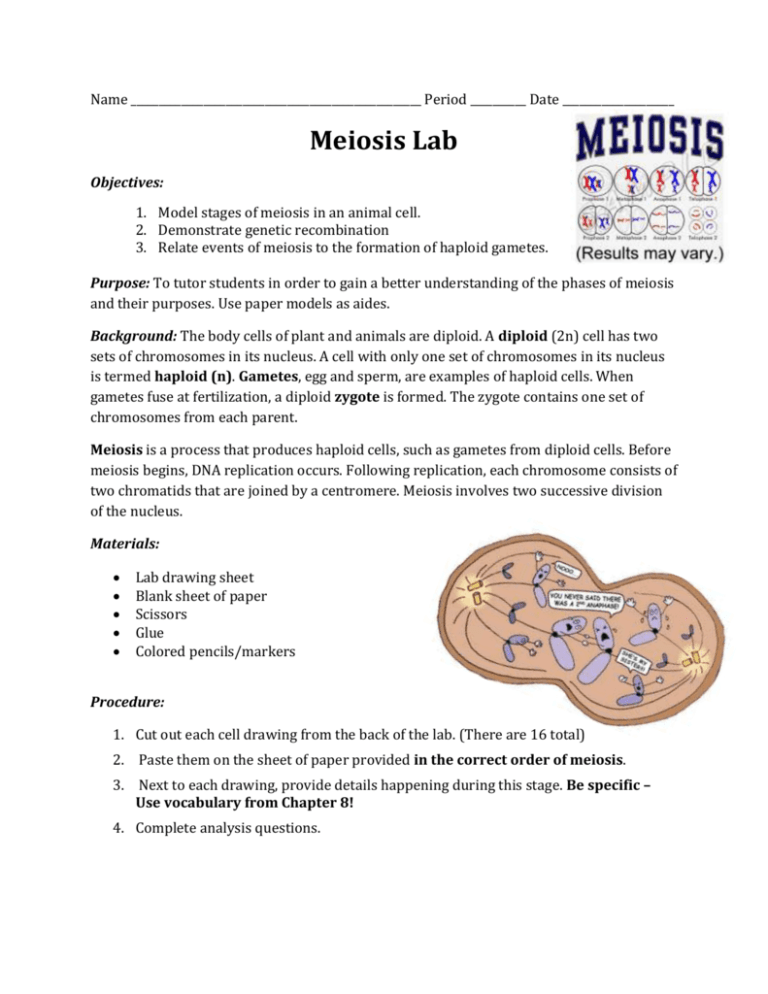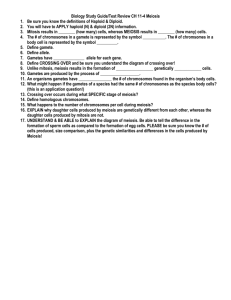Lab: Meiosis
advertisement

Name ____________________________________________________ Period __________ Date ____________________ Meiosis Lab Objectives: 1. Model stages of meiosis in an animal cell. 2. Demonstrate genetic recombination 3. Relate events of meiosis to the formation of haploid gametes. Purpose: To tutor students in order to gain a better understanding of the phases of meiosis and their purposes. Use paper models as aides. Background: The body cells of plant and animals are diploid. A diploid (2n) cell has two sets of chromosomes in its nucleus. A cell with only one set of chromosomes in its nucleus is termed haploid (n). Gametes, egg and sperm, are examples of haploid cells. When gametes fuse at fertilization, a diploid zygote is formed. The zygote contains one set of chromosomes from each parent. Meiosis is a process that produces haploid cells, such as gametes from diploid cells. Before meiosis begins, DNA replication occurs. Following replication, each chromosome consists of two chromatids that are joined by a centromere. Meiosis involves two successive division of the nucleus. Materials: Lab drawing sheet Blank sheet of paper Scissors Glue Colored pencils/markers Procedure: 1. Cut out each cell drawing from the back of the lab. (There are 16 total) 2. Paste them on the sheet of paper provided in the correct order of meiosis. 3. Next to each drawing, provide details happening during this stage. Be specific – Use vocabulary from Chapter 8! 4. Complete analysis questions. Analysis Questions 1. What is the function of the centromere? _________________________________________________________________________________________________ _________________________________________________________________________________________________ _________________________________________________________________________________________________ 2. How many cells are made at the end of meiosis and what are they called? _________________________________________________________________________________________________ _________________________________________________________________________________________________ _________________________________________________________________________________________________ 3. What difference is prophase in mitosis to meiosis? _________________________________________________________________________________________________ _________________________________________________________________________________________________ _________________________________________________________________________________________________ 4. Explain why meiosis is important in sexual reproduction. _________________________________________________________________________________________________ _________________________________________________________________________________________________ _________________________________________________________________________________________________ 5. How does crossing over affect the rate of evolution? _________________________________________________________________________________________________ _________________________________________________________________________________________________ _________________________________________________________________________________________________ 6. What would happen if homologus chromosomes did not pair up during prophase I. _________________________________________________________________________________________________ _________________________________________________________________________________________________ _________________________________________________________________________________________________ 7. How does prophase I differ from prophase II? _________________________________________________________________________________________________ _________________________________________________________________________________________________ _________________________________________________________________________________________________ 8. How does metaphase in mitosis differ from metaphase I and metaphase II. _________________________________________________________________________________________________ _________________________________________________________________________________________________ _________________________________________________________________________________________________ 9. Why are the end results of meiosis haploid cells? _________________________________________________________________________________________________ _________________________________________________________________________________________________ 10. Why is it that siblings are not identical to each other if the genes are from both of the same parents? What process creates this variation? _________________________________________________________________________________________________ _________________________________________________________________________________________________ _________________________________________________________________________________________________







